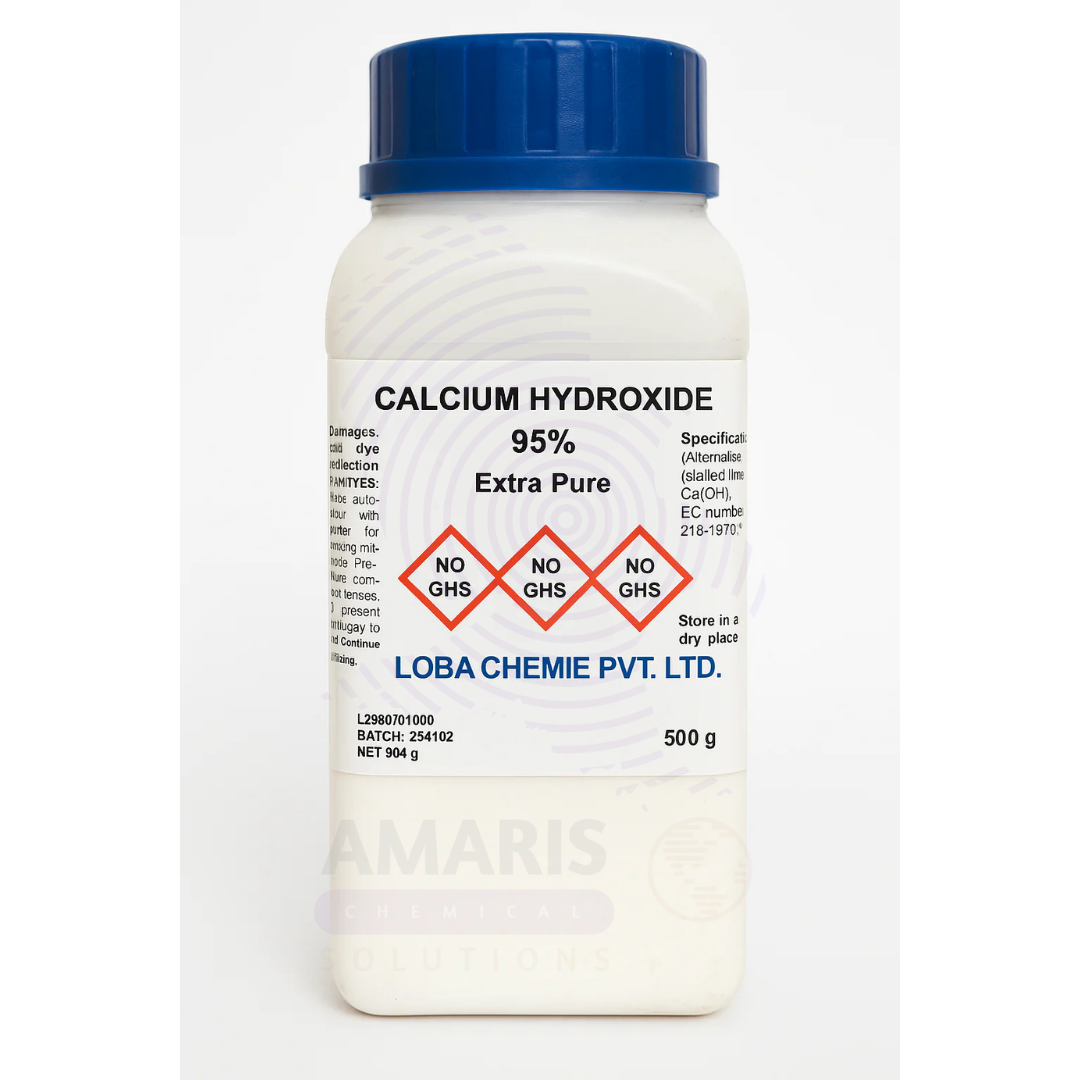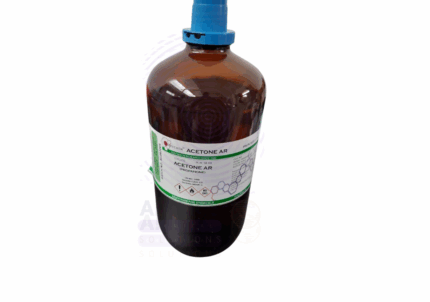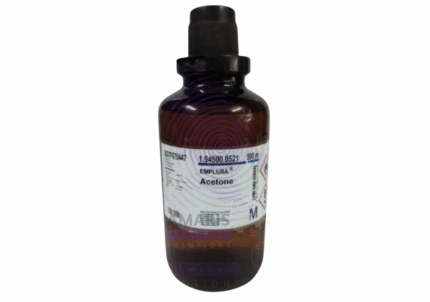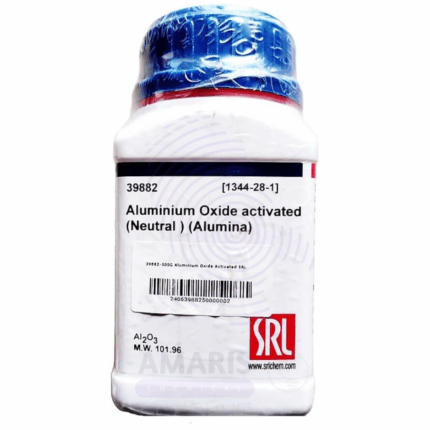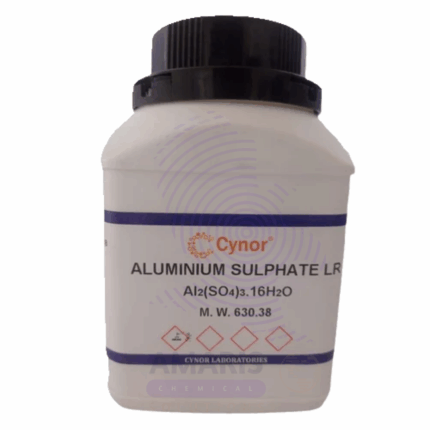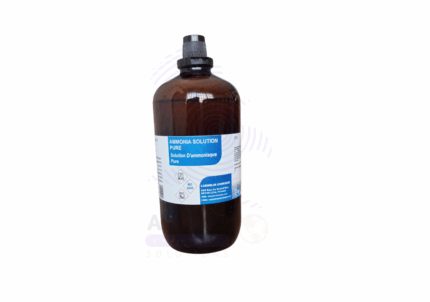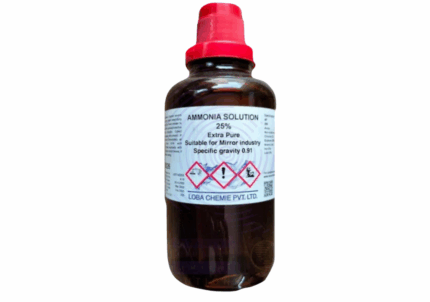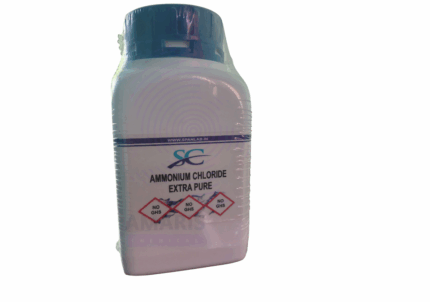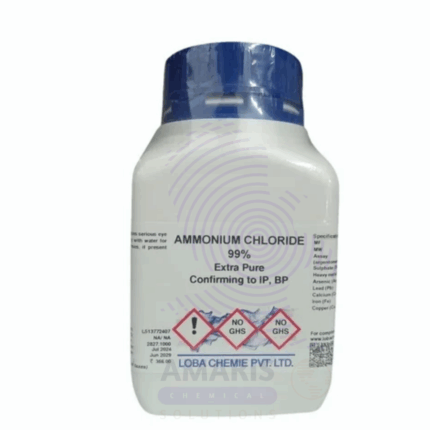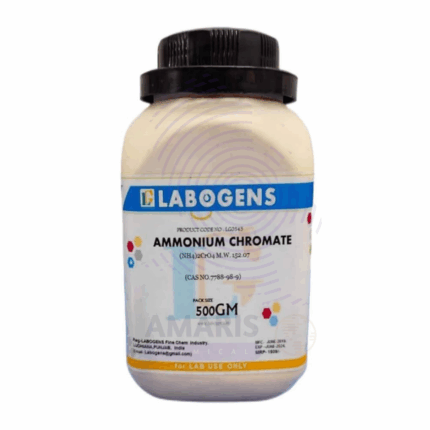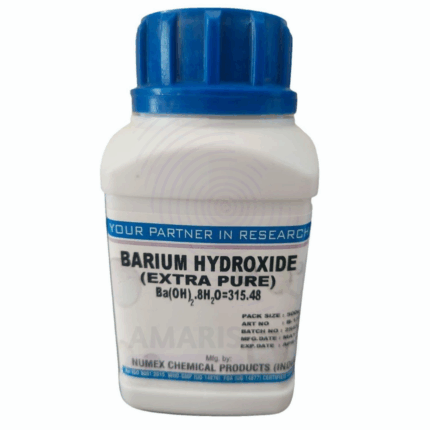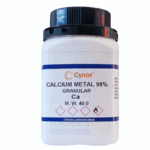
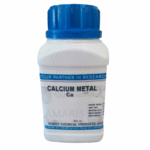
Calcium Hyroxide Extra Pure
$ 18.00 Original price was: $ 18.00.$ 17.34Current price is: $ 17.34.
Calcium Hyroxide Extra Pure is a finely powdered, high-purity inorganic compound commonly used in laboratories as a strong base, pH adjuster, and reagent in qualitative and quantitative analysis. It is widely employed in acid-base titrations, preparation of limewater for carbon dioxide detection, and precipitation reactions involving metal ions. Its strong alkalinity also makes it useful in studying saponification, neutralization, and hydration processes. The extra pure grade ensures minimal impurities, making it suitable for sensitive analytical procedures and educational demonstrations. It should be stored in tightly sealed containers to prevent carbonation and moisture absorption, which can affect its chemical properties.
Calcium Hyroxide Extra Pure
Primary Uses
- Standard Alkali for Acid-Base Titrations
- Used as a mild base in volumetric analysis and titrations, especially when standardizing weak acids or in reactions where stronger alkalis (e.g., NaOH) may interfere.
- Preparation of Limewater for CO₂ Testing
- Saturated solution (limewater) is used to detect carbon dioxide via precipitation of calcium carbonate—a classic qualitative test in educational chemistry labs.
- Reagent in Inorganic Precipitation Reactions
- Involved in double displacement and precipitation reactions, such as forming metal hydroxides for separation or identification purposes.
- pH Adjustment and Buffering Agent
- Used in buffer preparation and to maintain or raise pH in reactions that require weak alkali conditions.
Secondary Uses
- Demonstrating Solubility and Equilibrium Principles
- Useful in teaching concepts of saturated solutions, Ksp (solubility product), and dynamic equilibrium using limewater systems.
- CO₂ Absorbent in Controlled Experiments
- Sometimes used to trap or remove CO₂ from reaction atmospheres or closed systems.
- Microbial or Sterilization Studies
- Its alkaline nature makes it useful in bacterial inhibition experiments or basic pH sterilization methods for media in microbiology labs.
| PACK SIZE |
500 grams Plastic Tin |
|---|
1. Basic Identification Attributes
- Chemical Name: Calcium Hydroxide
- Chemical Formula: Ca(OH)₂
- CAS Number: 1305-62-0
- HS Code: 2825.90.00
- Grade: Extra Pure (Laboratory Grade)
- Synonyms: Slaked Lime, Hydrated Lime, Caustic Lime
2. Physical & Chemical Properties
- Appearance: White powder or colorless crystals
- Odor: Odorless
- Molar Mass: 74.09 g/mol
- Melting Point: ~580 °C (decomposes)
- Solubility:
- Slightly soluble in water (~1.73 g/L at 20 °C)
- Forms a basic solution (limewater)
- pH (saturated solution): ~12.4
- Reactivity: Reacts with acids, CO₂, and ammonium salts
3. Safety & Hazard Attributes
- GHS Classification:
- Skin Irritant (Category 2)
- Eye Damage (Category 1)
- Hazard Statements:
- H315: Causes skin irritation
- H318: Causes serious eye damage
- Precautionary Statements:
- Wear protective gloves and eye protection
- Avoid breathing dust
- Wash hands thoroughly after handling
- NFPA Ratings:
- Health: 2
- Flammability: 0
- Reactivity: 1
4. Storage & Handling Attributes
- Storage Conditions:
- Store in tightly closed containers
- Keep in a dry, cool, well-ventilated area
- Protect from moisture and carbon dioxide (can convert to calcium carbonate)
- Packaging: Plastic jars, HDPE bottles, moisture-resistant containers
- Handling Precautions:
- Avoid dust generation
- Handle under fume hood if large quantities are involved
5. Regulatory & Compliance Attributes
- Transport Classification: Not classified as hazardous for transport
- Disposal Considerations:
- Neutralize with dilute acid before disposal
- Dispose of in accordance with local regulations for alkaline chemicals
6. Environmental & Health Impact
- Toxicity:
- Low systemic toxicity
- Causes severe eye and skin irritation on contact
- Ecotoxicity:
- Alkaline material may disrupt pH in aquatic environments
- Biodegradability: Not applicable (inorganic base)
SAFETY PRECAUTIONS
- Personal Protective Equipment (PPE):
- Wear chemical splash goggles, gloves, lab coat, and optionally a face shield.
- Use a dust mask or respirator if dust is generated.
- Handling:
- Handle in a well-ventilated area.
- Avoid inhalation of dust and contact with eyes or skin.
- Do not mix with acids without proper precautions — can generate heat.
- Storage:
- Store in a cool, dry, tightly closed container.
- Keep away from moisture, incompatible materials (acids, ammonium salts), and CO₂ (reacts to form calcium carbonate).
FIRST AID MEASURES
- Inhalation:
- Move person to fresh air.
- If breathing is difficult, provide oxygen and seek medical attention.
- Skin Contact:
- Immediately wash with soap and water.
- Remove contaminated clothing.
- Seek medical attention if irritation persists.
- Eye Contact:
- Rinse cautiously with water for at least 15 minutes.
- Lift eyelids occasionally.
- Seek immediate medical assistance.
- Ingestion:
- Rinse mouth with water.
- Do not induce vomiting.
- Give water to dilute and seek immediate medical attention.
FIRE FIGHTING MEASURES
- Flammability:
- Not flammable.
- However, it reacts exothermically with water and acids, which can intensify a fire.
- Extinguishing Media:
- Use water spray, dry chemical, foam, or CO₂ for surrounding fires.
- Do not use water directly on dry powder — may cause heat and spattering.
- Hazardous Combustion Products:
- May emit calcium oxide and irritating vapors when heated.
- Firefighter Protection:
- Wear SCBA and full protective gear.
- Avoid creating airborne dust during firefighting.


 Preservatives(food)
Preservatives(food) Flavor Enhancers
Flavor Enhancers Acidulants
Acidulants Sweeteners
Sweeteners Antioxidants
Antioxidants Colorants(food)
Colorants(food) Nutraceutical Ingredients (food)
Nutraceutical Ingredients (food) Nutrient Supplements
Nutrient Supplements Emulsifiers
Emulsifiers
 Collectors
Collectors Dust Suppressants
Dust Suppressants Explosives and Blasting Agents
Explosives and Blasting Agents Flocculants and Coagulants
Flocculants and Coagulants Frothers
Frothers Leaching Agents
Leaching Agents pH Modifiers
pH Modifiers Precious Metal Extraction Agents
Precious Metal Extraction Agents
 Antioxidants(plastic)
Antioxidants(plastic) Colorants (Pigments, Dyes)
Colorants (Pigments, Dyes) Fillers and Reinforcements
Fillers and Reinforcements Flame Retardants
Flame Retardants Monomers
Monomers Plasticizers
Plasticizers Polymerization Initiators
Polymerization Initiators Stabilizers (UV, Heat)
Stabilizers (UV, Heat)
 Antifoaming Agents
Antifoaming Agents Chelating Agents
Chelating Agents Coagulants and Flocculants
Coagulants and Flocculants Corrosion Inhibitors
Corrosion Inhibitors Disinfectants and Biocides
Disinfectants and Biocides Oxidizing Agents
Oxidizing Agents pH Adjusters
pH Adjusters Scale Inhibitors( water)
Scale Inhibitors( water)
 Antioxidants(cosmetic)
Antioxidants(cosmetic) Emollients
Emollients Fragrances and Essential Oils
Fragrances and Essential Oils Humectants
Humectants Preservatives
Preservatives Surfactants(cosmetic)
Surfactants(cosmetic) Thickeners
Thickeners UV Filters
UV Filters
 Fertilizers
Fertilizers Soil Conditioners
Soil Conditioners Plant Growth Regulators
Plant Growth Regulators Animal Feed Additives
Animal Feed Additives Biostimulants
Biostimulants Pesticides (Herbicides, Insecticides, Fungicides)
Pesticides (Herbicides, Insecticides, Fungicides)
 Active Pharmaceutical Ingredients (APIs)
Active Pharmaceutical Ingredients (APIs) Excipients
Excipients Solvents(pharmaceutical)
Solvents(pharmaceutical) Antibiotics
Antibiotics Antiseptics and Disinfectants
Antiseptics and Disinfectants Vaccine Adjuvants
Vaccine Adjuvants Nutraceutical Ingredients (pharmaceutical)
Nutraceutical Ingredients (pharmaceutical) Analgesics & Antipyretics
Analgesics & Antipyretics
 Analytical Reagents
Analytical Reagents Solvents(lab)
Solvents(lab) Chromatography Chemicals
Chromatography Chemicals Spectroscopy Reagents
Spectroscopy Reagents microbiology-and-cell-culture-reagents
microbiology-and-cell-culture-reagents Molecular Biology Reagents
Molecular Biology Reagents Biochemical Reagents
Biochemical Reagents Inorganic and Organic Standards
Inorganic and Organic Standards Laboratory Safety Chemicals
Laboratory Safety Chemicals Specialty Laboratory Chemicals(Special Laboratory Equipment)
Specialty Laboratory Chemicals(Special Laboratory Equipment)
 Demulsifiers
Demulsifiers Hydraulic Fracturing Fluids
Hydraulic Fracturing Fluids Scale Inhibitors(oil)
Scale Inhibitors(oil) Surfactants(oil)
Surfactants(oil) Drilling Fluids
Drilling Fluids
 Dyes and Pigments
Dyes and Pigments Bleaching Agents
Bleaching Agents Softening Agents
Softening Agents Finishing Agents
Finishing Agents Antistatic Agents
Antistatic Agents
 Admixtures
Admixtures Waterproofing Agents
Waterproofing Agents Sealants and Adhesives
Sealants and Adhesives Curing Compounds
Curing Compounds Concrete Repair Chemicals
Concrete Repair Chemicals Anti-Corrosion Coatings
Anti-Corrosion Coatings
 Surfactants(cleaning)
Surfactants(cleaning) Builders
Builders Enzymes
Enzymes Solvents (Cleaning)
Solvents (Cleaning) Fragrances
Fragrances
 Electronic Chemicals
Electronic Chemicals Catalysts
Catalysts Lubricants
Lubricants Photographic Chemicals
Photographic Chemicals Refrigerants
Refrigerants Automotive chemicals
Automotive chemicals Pyrotechnic Chemicals
Pyrotechnic Chemicals
 Biodegradable Surfactants
Biodegradable Surfactants Bio-based Solvents
Bio-based Solvents Renewable Polymers
Renewable Polymers Carbon Capture Chemicals
Carbon Capture Chemicals Wastewater Treatment Chemicals
Wastewater Treatment Chemicals
 Pigments
Pigments Solvents(paint)
Solvents(paint) Specialty Coatings
Specialty Coatings Binders/Resins
Binders/Resins Additives
Additives Driers
Driers Anti-Corrosion Agents
Anti-Corrosion Agents Functional Coatings
Functional Coatings Application-Specific Coatings
Application-Specific Coatings
 Fresh Herbs
Fresh Herbs Ground Spices
Ground Spices Whole Spices
Whole Spices Spice Blends
Spice Blends Dried Herbs
Dried Herbs
 Leavening Agents
Leavening Agents Dough Conditioners
Dough Conditioners Flour Treatments
Flour Treatments Fat Replacers
Fat Replacers Decoratives
Decoratives Preservatives(baking)
Preservatives(baking)
 Plasticizers & Softeners
Plasticizers & Softeners Reinforcing Agents
Reinforcing Agents Adhesion Promoters
Adhesion Promoters Vulcanizing Agents
Vulcanizing Agents Antidegradants
Antidegradants Blowing Agents
Blowing Agents Fillers & Extenders
Fillers & Extenders Accelerators & Retarders
Accelerators & Retarders